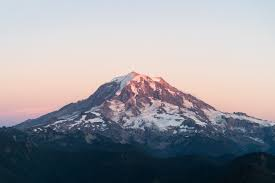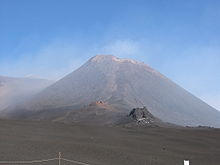A stratovolcano, also known as a composite volcano, is a conical volcano built up by many layers (strata) of hardened lava and tephra. Unlike shield volcanoes, stratovolcanoes are characterized by a steep profile with a summit crater and periodic intervals of explosive eruptions and effusive eruptions, although some have collapsed summit craters called calderas.
The lava flowing from stratovolcanoes typically cools and hardens before spreading far, due to high viscosity. The magma forming this lava is often felsic, having high-to-intermediate levels of silica (as in rhyolite, dacite, or andesite), with lesser amounts of less-viscous mafic magma. Extensive felsic lava flows are uncommon, but have travelled as far as 15 km.
Stratovolcanoes are sometimes called composite volcanoes because of their composite stratified structure, built up from sequential outpourings of erupted materials. They are among the most common types of volcanoes, in contrast to the less common shield volcanoes. Two famous examples of stratovolcanoes are Krakatoa in Indonesia, known for its catastrophic eruption in 1883, and Vesuvius in Italy, whose catastrophic eruption in AD 79 buried the Roman cities of Pompeii and Herculaneum. Both eruptions claimed thousands of lives. In modern times, Mount St. Helens in Washington State, USA and Mount Pinatubo in the Philippines have erupted catastrophically, but with fewer deaths.
Stratovolcanoes are common at subduction zones, forming chains and clusters along plate tectonic boundaries where oceanic crust is drawn under continental crust (continental arc volcanism, e.g. Cascade Range, Andes, Campania) or another oceanic plate (island arc volcanism, e.g. Japan, Philippines, Aleutian Islands). The magma forming stratovolcanoes rises when water trapped both in hydrated minerals and in the porous basalt rock of the upper oceanic crust is released into mantle rock of the asthenosphere above the sinking oceanic slab. The release of water from hydrated minerals is termed "dewatering", and occurs at specific pressures and temperatures for each mineral, as the plate descends to greater depths. The water freed from the rock lowers the melting point of the overlying mantle rock, which then undergoes partial melting and rises due to its lighter density relative to the surrounding mantle rock, and pools temporarily at the base of the lithosphere. The magma then rises through the crust, incorporating silica-rich crustal rock, leading to a final intermediate composition. When the magma nears the top surface, it pools in a magma chamber within the crust below the stratovolcano.
- Magma differentiation, in which the lightest, most silica-rich magma and volatiles such as water, halogens, and sulfur dioxide accumulate in the uppermost part of the magma chamber. This can dramatically increase pressures.
- Fractional crystallization of the magma. When anhydrous minerals such as feldspar crystallize out of the magma, this concentrates volatiles in the remaining liquid, which can lead to second boiling that causes a gas phase (carbon dioxide or water) to separate from the liquid magma and raise magma chamber pressures.
- Injection of fresh magma into the magma chamber, which mixes and heats the cooler magma already present. This could force volatiles out of solution and lower the density of the cooler magma, both of which increase pressure. There is considerable evidence for magma mixing just before many eruptions, including magnesium-rich olivine crystals in freshly erupted silicic lava that show no reaction rim. This is possible only if the lava erupted immediately after mixing since olivine rapidly reacts with silicic magma to form a rim of pyroxene.
- Progressive melting of the surrounding country rock.
These internal triggers may be modified by external triggers such as sector collapse, earthquakes, or interactions with groundwater. Some of these triggers operate only under limited conditions. For example, sector collapse (where part of the flank of a volcano collapses in a massive landslide) can trigger eruption only of a very shallow magma chamber. Magma differentiation and thermal expansion also are ineffective as triggers for eruptions from deep magma chambers. Whatever the precise mechanism, the pressure in the magma chamber increases to a critical point where the roof of the magma chamber fractures, and the contents of the magma chamber are provided with a path to the surface through which to erupt.
Hazard
In recorded history, explosive eruptions at subduction zone (convergent-boundary) volcanoes have posed the greatest hazard to civilizations. Subduction-zone stratovolcanoes, such as Mount St. Helens, Mount Etna and Mount Pinatubo, typically erupt with explosive force: the magma is too stiff to allow easy escape of volcanic gases. As a consequence, the tremendous internal pressures of the trapped volcanic gases remain and intermingle in the pasty magma. Following the breaching of the vent and the opening of the crater, the magma degasses explosively. The magma and gases blast out with high speed and full force.
Since 1600 CE, nearly 300,000 people have been killed by volcanic eruptions. Most deaths were caused by pyroclastic flows and lahars, deadly hazards that often accompany explosive eruptions of subduction-zone stratovolcanoes. Pyroclastic flows are swift, avalanche-like, ground-sweeping, incandescent mixtures of hot volcanic debris, fine ash, fragmented lava, and superheated gases that can travel at speeds over 160 km/h. Around 30,000 people were killed by pyroclastic flows during the 1902 eruption of Mount Pelée on the island of Martinique in the Caribbean. In March to April 1982, three explosive eruptions of El Chichón in the State of Chiapas in southeastern Mexico, caused the worst volcanic disaster in that country's history. Villages within 8 km (5 mi) of the volcano were destroyed by pyroclastic flows, killing more than 2,000 people.
Two Decade Volcanoes that erupted in 1991 provide examples of stratovolcano hazards. On June 15, Mount Pinatubo spewed an ash cloud 40 km into the air and produced huge pyroclastic surges and lahar floods that devastated a large area around the volcano. Pinatubo, located in Central Luzon just 90 km west-northwest from Manila, had been dormant for 6 centuries before the 1991 eruption, which ranks as one of the largest eruptions in the 20th century. Also in 1991, Japan's Unzen Volcano, located on the island of Kyushu about 40 km east of Nagasaki, awakened from its 200-year slumber to produce a new lava dome at its summit. Beginning in June, the repeated collapse of this erupting dome generated ash flows that swept down the mountain's slopes at speeds as high as 200 km/h. Unzen is one of more than 75 active volcanoes in Japan; an eruption in 1792 killed more than 15,000 people-the worst volcanic disaster in the nation's history.
The eruption of Mount Vesuvius in 79 completely smothered the nearby ancient cities of Pompeii and Herculaneum with thick deposits of pyroclastic surges and lava flows. Although the death toll is estimated between 13,000 and 26,000 remains, the exact number is still unclear. Vesuvius is recognized as one of the most dangerous volcanoes, due to its capacity for powerful explosive eruptions combined with the high population density of the surrounding Metropolitan Naples area (totaling about 3.6 million inhabitants).









No comments:
Post a Comment